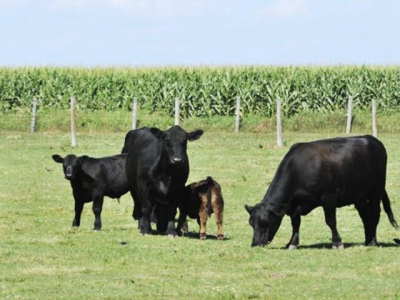Cattle preconditioning programs add to bottom line

Extension specialists describe how preconditioning programs add to cow/calf operation's bottom line and improve return on investment.
Cattle producers looking to improve their return on investment (ROI) should consider preconditioning calves before taking them to market, extension specialists told attendees at a recent University of Arkansas Livestock & Forestry Station field day.
The field day, “Improve Your Odds for ROI,” featured a look at Arkansas’ new preconditioning program, GoGREEN, and examined how preconditioning adds to producers’ bottom lines. Additionally, cattle genetics expert offered specifics on pregnancy detection and the benefits of a defined breeding season, the University of Arkansas said in an announcement.
Preconditioning
Preconditioning is a collection of best management practices meant to make calves healthier and heavier by the time they go to market, the specialists said, explaining that preconditioning includes vaccination, ridding calves of internal and external parasites and making sure they are fully healed from dehorning and castration. This also include ensuring that calves understand how to eat from a bunker and drink from water tanks.
Shane Gadberry, professor and extension ruminant nutrition specialist for the University of Arkansas System Division of Agriculture, said preconditioning also means handling calves so they aren’t afraid of people and can be approached to receive medical care, if needed.
“The one thing that makes preconditioning easy is having a controlled breeding and calving season,” Gadberry said. “It’s a lot easier to implement a preconditioning program when most calves are born and weaned around the same time -- either once or twice a year.”
“I believe preconditioning is the apex, the pinnacle of cow/calf management,” University of Missouri Extension state beef nutritionist Eric Bailey said.
“The majority of the value of a preconditioning program is not in the premium at sale,” he said. “The bottom line to an individual cow/calf producer is that you sell more pounds of beef.”
Bailey pointed to research showing that preconditioning can help lower the chances of a calf contracting bovine respiratory disease, which typically results in a 75% feedlot mortality rate. Those losses amount to $2 billion a year.
A study of 11 years of preconditioning on a single farm found that the average profit per head was $68.95, with 63% of that profit due to additional pounds sold, he said.
In answer to an audience question, Bailey emphasized that preconditioning isn’t a matter of using just one tool from a toolbox. “You can’t outrun bad management with a bottle,” Bailey said. “Vaccines aren’t the guarantee you’re going to have performance from these animals. Consider the whole system; vaccines are just a component of a preconditioning system.”
Bailey also cautioned that preconditioning is a commitment. “Get your cow/calf management right before you attempt to dive blindly into preconditioning,” he said. “If you’re not there yet, get with your county agent.”
Arkansas program
The Arkansas Cooperative Extension Service rolled out its GoGREEN preconditioning program in 2018. Gadberry discussed how timing for calving can affect prices producers receive at market if they immediately sell calves as six-month-old weanlings.
Pointing to a graph showing steer price fluctuations throughout the year, Gadberry noted that prices were the “lowest in fall, because we produce a lot of calves in the spring. It’s sheer supply relative to the demand.”
Gadberry recommended retaining calves for an additional 60 days after weaning in order to add weight to them.
“As we add weight, we’re adding dollars,” he said. “In recent years, we’ve seen market prices increase from May to July. Producers with fall-born calves often wean in May. Holding those calves a couple of months, when grass is usually abundant, can add dollars to the bottom line.”
Feeding for gain
Oklahoma State University beef cattle extension specialist Paul Beck presented research that pointed to the use of cool annual forages to promote calf weight gain in the fall and spring.
Compared to fescue or hay and supplements of mixed feeds, “wheat pastures offer us a unique resource with some great potential for weight gains,” he said. “It’s a cheaper and more profitable option for growing purchased or retained stocker calves.”
Breeding, calving
Charles Looney, extension cattle genetic specialist for the University of Arkansas Division of Agriculture, emphasized the bottom-line benefits of moving to a defined breeding and calving season.
“I grew up on a farm that had calves all year,” he said. “Calving all year is not what is best. What is most cost effective is for vaccinating and deworming to be done on all calves at the same time instead of individually.”
Looney said ranchers needed to look at testing the reproductive tract soundness of both heifers and bulls, especially with research showing a $22 return on every dollar spent on breeding soundness testing.
Related news
 Can mastitis treatment affect gut microbiome in dairy cattle?
Can mastitis treatment affect gut microbiome in dairy cattle? Mastitis infusions probed for links to antibiotic-resistant bacteria in intestinal microbiome of dairy cattle.
 Study Starch source influential in dairy cow diets
Study Starch source influential in dairy cow diets Corn processing and reduced crude protein degradability may influence milk ethanol stability, say researchers.
 Cow/calf producers reminded to conduct bull soundness exam
Cow/calf producers reminded to conduct bull soundness exam Spring-like weather means cow/calf producers need to get bulls ready for the upcoming breeding season.